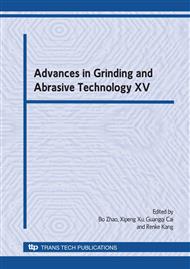p.205
p.210
p.216
p.223
p.228
p.234
p.238
p.243
p.248
Design of Simultaneous Ultrasonic Effects in Grinding and Electrofinishing on Taper Hole
Abstract:
The current study involves the use of ultrasonic vibration of the electrolyte to assist in removing electrolytic product and cuttings from the machining gap in the surface finish process of grinding and electro-finishing the inside surface of a tapered hole. The design of the finish-tool includes a taper grinding-tool joined to an electrode. In the experiment, the finish-tool is gradually fed into the taper hole and the electrode is used with continuous or pulsed direct current. The experimental results show that a high current together with ultrasonic vibration is effective in material removal and in the improvement of the finishing effect. The average effect of the ultrasonic vibration is greater than that of the pulsed current while the machining time need not be longer than the off-time. The finishing effect is better with a wide gap between the grinding-tool and the electrode. A high rotational speed of the finish-tool guides and discharges the dregs and cuttings efficiently and also improves the finish. The simultaneous use of ultrasonics with grinding and electro-finishing (SUGEF) also shortens the time it takes make the inside wall of the tapered hole smooth and bright.
Info:
Periodical:
Pages:
228-233
Citation:
Online since:
September 2009
Authors:
Keywords:
Price:
Сopyright:
© 2009 Trans Tech Publications Ltd. All Rights Reserved
Share:
Citation:


